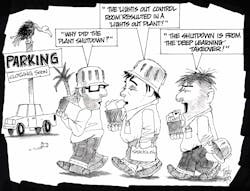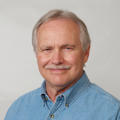Control Talk: Machine learning, deep learning and nonlinear controls
I was impressed with a presentation by Vivek R. Dabholkar, titled “Engineered DMC models with incremental mass balance constraints,” and his comments on nonlinear control at the AIChE 2023 Spring Meeting. AIChE is an organization for chemical engineers. We’re fortunate to take a break from the conversations with my mentor self and have Dabholkar, principal APC engineer at Ineos Group’s olefins plant in Chocolate Bayou, Texas, give his view on new technologies touted today.
Dabholkar started out as a pyrolysis modeler/APC engineer at Stone & Webster Corp., and worked for the consulting firm Setpoint, which was acquired by Aspen Tech six months after he joined. He was then hired as the first employee at AMT. Dabholkar also has 15 years of operating experience as a senior engineer at ExxonMobil’s Baytown, Texas, olefins plant and at the Exxon joint venture Kemya, KSA, where he improved bottom-line profitability by improvising and implementing plantwide DMC/composite. After a short stay at Shell Polymers’ new cracker in Monaca, Pa., he improved the performance of the composite at Dow Chemicals by retesting and reidentifying the cold side of an olefins plant in Canada, enabling it to push-feed against changing backend plant constraints.
GREG: What are your thoughts on recent developments in machine learning, deep learning and nonlinear controls?
VIVEK: On one hand, I want to embrace new ideas to implement them in industrial systems, keeping pace with modern developments, but underlying fundamentals tell me otherwise. The “sacred golden” principle of superposition is only valid for linear systems, no exceptions. In other words, one can’t superimpose the effect of past independent moves along with the calculated future independent moves to calculate their combined effect on controlled variables. This is a fundamental hurdle in practical applications of so-called “nonlinear control.”
GREG: How are linear controllers able to cope with the nonlinearity encountered in practice?
VIVEK: Over the years, APC engineers learned to implement global linearization of control valves with respect to flow. So, the entire range of operation changes in the transformed valve, which is essentially a scaled flow, is linear with respect to flow. As a result, everything of interest in the transformed domain still behaves linearly, and the end results are anti-transformed, so they can be understood by the operators and engineers. This idea was also employed to control level in the horizontal drums within high/low limits by linearizing the level response accounting for the change in surface area based on the distance of level from the central plane.
Delta-Ps (differential pressure) in high-reflux columns have been transformed by using scaled internal reflux flow, log or piece-wise linear transformation for tower compositions, and the list goes on. Even for the hard problem of pH Control, I came across “Characterizer for control loops” by F. G. Shinskey, May 1999, where both setpoint and PV of a pH control loop must be transformed. Essentially, the transformed pH PID output moves very slowly, where rise in pH is rapid because the perceived deviation seen by the PID algorithm is small in the transformed domain but moves rapidly where change in pH is small or nearly “flat.”
GREG: The benefits of using signal characterization to linearize process variables (PV) and manipulated variables (MV) are extensive. The dynamics from open-loop response tests aren’t size- and operating-point dependent and filtering of noise is more effective. Without signal characterization the open-loop, self-regulating process gain approaches the slope of the plot of PV versus MV for small steps but becomes quite different for larger steps spanning various changes in slope. The change in slope can be a magnitude or more for pH systems and nonlinear installed flow characteristics of control valves. Without signal characterization the beneficial effects of a process time constant from the residence time in a well-mixed volume can be lost. For a truly strong acid and strong base system, a 20-minute process time constant can be reduced to a fraction of a minute due to acceleration as the pH approaches the neutral point. Also, without signal characterization the bias in a PV can be large after filtering noise due to the deviation above and below the operating point being quite different.
The reduction in dead time by output signal characterization from resolution and lost motion stems from not having to tune the PID with a smaller gain for the steeper portions of the installed flow characteristic for valves and variable frequency drives. A higher PID gain translates to a greater CO rate of change for a given disturbance, which reduces the time to get through the resolution and lost motion dead band and reduces the dead time from positioners’ sensitivity limitation. The lost motion of “high-performance valves” (tight shutoff rotary valves) posing as throttling valves can be 8% or more. For a step signal smaller than 0.4%, the sensitivity limitation of many single-stage positioners can increase the dead time from 0.4 to 20 seconds for a step in same direction and to 40 seconds for a step in the opposite direction. The amplitude of a limit cycle from a resolution limitation is proportional to the open-loop process gain that is the product of the valve gain, process gain and measurement gain. Consequently, the amplitude from a resolution limitation by signal characterization will be reduced in the regions where the process gain was high. This is particularly important for uncharacterized pH control involving steep titration curves.
Also, there are operational and maintenance benefits. The reduction in variability seen increases engineering and operations confidence and appreciation of signal characterization. For better operator understanding and maintainability, characterization is best done in the main control system rather than in field devices and original uncharacterized signals made clearly visible.
Some words of caution. The titration curve and slope in the neutral region is highly dependent on absorption of carbon dioxide from simple exposure to air. The actual slope near 7 pH is orders of magnitude less than the theoretical slope for a strong acid and strong base system. The slope of the installed flow characteristic of a control valve and variable speed drive is highly dependent on the ratio of the valve pressure drop and static pressure, respectively, to system pressure drop. The inherent flow characteristic for different types of control valves and inverters is also significant.
GREG: How does a linear multivariable controller handle fast (front-end)/slow (back-end) dynamics, for example, in case of an olefins plant where composite/CLP is implemented?
VIVEK: Since the steady-state targets for the front- and back-end constraints aren’t dynamically aligned, APC engineers traditionally used CVStep (steady-state change in CV target) for up and down directions to limit total furnace feed movement, so feed is pushed slowly against the back end (cold-side). There are issues with this approach, especially with respect to CVStep-down; this is when MPC gives up on feed-limiting, back-end constraints for few cycles depending on size of CVStep down. This is the main reason I don’t like using small CVStep-down to restrict feed-cutting.
Often, the CVstep-up is programmed in monotonically decreasing staircase pattern, knowing the history of total feed the back-end constraints can handle. But this results in abrupt changes to CVStep around the transition points. Based on total furnace feed, one can revise this based on smoother piece-wise linear function (PWLN) with respect to total feed. Unfortunately, even this approach leaves money on the table as feed pushing capability is greatly reduced during the summer versus winter. I’ve used variable node values for total feed in the PWLN function to account for seasonality.
Another approach was first introduced by Doug Raven, an engineering specialist at Saudi Aramco. The idea is to push the front-end, feed flow-manipulated variable further into the future by using lower, move-suppression multipliers on furnace feeds. The lets the controller move smaller at first, so the back-end has a chance to respond. Care must be taken not to overdo it, or else important front-end furnace constraints, such O2 and draft output may not be adequately honored dynamically.
GREG: Do you foresee any applications of machine learning in the chemical industry or refineries?
VIVEK: I see applications where a lot of manual steps are required with the lack of repeatability, for example, procedure-based decoking of furnaces or swapping of charge gas dryers. It would free operators from constantly watching the process over a long period of time and would lead to consistently safe transitions.
GREG: I think the potential for machine learning to supplement procedure automation for handling startups, shutdowns, transitions and abnormal operating conditions may be significant. I’ve extensively used procedure automation to automate difficult compressor and unit operation startups based on learning what operators have done and what first-principle dynamic process simulations confirm are good sequences.
Before we move on to machine learning we need to start with knowledge from plant operations, first principles, open loop tests, and what experts have documented in the ISA-TR106.00.01 and ISA-TR106.00.02 technical reports on procedure automation. See the Control Talk Column “Continuous improvement of continuous processes” with the leader of this technology
A major concern is the unrealistic expectation that machine learning can replace PID and MPC in the process industries. For machine control, the dead times are usually insignificant, and the servo mechanism response is fast and precise. In the process industry, the dead times can be large and vary with operating point, and the control valves and variable speed drives have resolution limits, rate limits and dead band. Replacing PID and MPC is potentially unsafe.
GREG: What are the opportunities for neural networks?
VIVEK: I’m not an expert in application of neural networks, and I’ve yet to witness a working multivariable control application despite all the publicity it gathered decades ago. Once again, the principle of superposition is a big hurdle. However, neural networks may be used in inferential measurement (soft sensor) development, with a good amount of validation and cross-checking on selected variables using PCA to avoid unreliable results. They can be used for pattern detection applied to fault detection and diagnosis by studying variable movements prior to, for example, equipment failures in the past. This know-how could then by applied to predict failures before they happen. They could also predict raw material prices based on past patterns among many variables and discrete events along with the current events that could trigger similar responses.
Top 10 things you don’t want to hear from executives
10. We are replacing the DCS with a “supercomputer.”
9. We don’t need better measurements; we just need more neural networks.
8. We don’t need better control valves to eliminate limit cycles, we just need machine learning.
7. Control engineers are plug-and-play. You do not need intimate process understanding. Modern MPC software makes up for everything.
6. I don’t want anything that requires PID or model predictive control expertise.
5. Deep learning will tell us all we will need to know.
4. MPC by inherent design honors incremental material balance, you do not need domain expertise to make it work.
3. Machine learning is our future. You are our past.
2. Here is your dismissal notice.
1. The money not spent on instrumentation, systems and engineers can be used to hire data scientists.
About the Author
Greg McMillan
Columnist
Greg K. McMillan captures the wisdom of talented leaders in process control and adds his perspective based on more than 50 years of experience, cartoons by Ted Williams and Top 10 lists.

Leaders relevant to this article:

